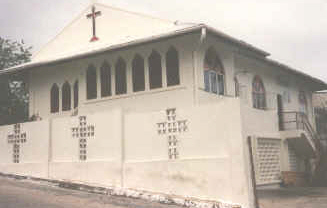 The clowns were based at the San Fernando Baptist Church (SFBC) in San Fernando, Trinidad.
The clowns were based at the San Fernando Baptist Church (SFBC) in San Fernando, Trinidad.This article is an overview of the clown evangelism mission trip from the perspective of Dale Lee,
the clown team leader. The mission trip was conducted on May 21-30, 1993. The trip was
organized through the International Mission Board of the Southern Baptist Convention.
Before I agreed to go to Trinidad, I had to find out where it was located. I knew it was a
Caribbean island. I thought it was an island that cruise ships often included in their schedules.
That is all I knew. I went to the library to find out more information.
I accepted the responsibility of serving as the clown mission team leader which was responsible
for organizing the team and planning the programs the clowns would perform. I learned to be a
clown team mission leader by being a clown mission team leader.
The clowns on our mission trip would be the participants of a performance. From what I could
find out, this was the first time clowns would present a total program for a performance. A
human would introduce the clowns. At the end of the program the human would invite people to
attend the San Fernando Baptist Church.
I decided to use the design concepts I used to design a program presented by Slow Beau and
Little Lee. With this design approach, I was able to feel comfortable with creating generic clown
programs for schools, churches, day-care centers, etc.
A typical clown program was 30 to 40 minutes long. Normally, the clowns had the privilege of
going longer than the agreed on length of the program.
Trinidad is an island that is a part of the country, Republic of Trinidad & Tobago. Trinidad & Tobago became a country on August 31, 1962. Port of Spain is the capital city, and it is located on the island of Trinidad. Trinidad is about seven miles off the eastern coast of the South American country, Venezuela. The island of Trinidad has been controlled by Spain, France, and England.
Many of the people living in Trinidad have ancestors from Africa and India that went to Trinidad
to work on the plantations. The people of Trinidad can trace their ancestors to Africa, India,
Spain, France, and England. The culture of Trinidad & Tobago is a blend of these cultures.
It was a relief to find out that the official language of Trinidad is English and the public water was
safe to drink.
I had many questions that I could only obtain partial answers before leaving for Trinidad. I would
not know the exact answers until I was in Trinidad. The belief that God would give me directions
when I needed them helped calm my anxieties. I offered many prayers to God as I planned for the
trip.
One specific event has stayed with me and continues to be a source of encouragement for me. I
had owned an illusion, “Freddy,” for about a year. I had not used it, because I could not get it to
work. The illusion packed small and played big which was very important to me, because luggage
space was limited. The day before I was to leave on the trip, I decided to call the creator of the
illusion to get any other instructions on how to perform the illusion. His name was Doc Haley.
He was a magician and owned a printing company. He produced Christian based magic illusions.
To my surprise, Doc answered the phone when I called. He told me to forget the instructions that
came with the illusion, and he would give me better instructions. The new instructions were
simple, and I was able to perform the illusion. This illusion became the most performed skit and
illusion used by the clowns during the trip. The illusion dealt with alcohol, drugs, and smoking
which are common problems for youth in Trinidad.
I took a chance hoping I would get to talk to someone that would give me some pointers on how
to use the illusion. There is no doubt in my mind that God gave me the idea to call Doc Haley. I
was hesitant, because I did not want another long distance phone bill. I am now more willing to
act on thoughts I have that are not supported by logic and reasoning. To me this is called FAITH.
Changes to the daily schedule occurred constantly, which typically meant the planned programs
for that day would be impacted by the time allowed for the programs or when specific
performances would be conducted. I tried to make decisions that I thought was best for all the
clowns. My decisions were not 100 percent approved by all clowns. My decisions were
accompanied by prayers.
During the trip, the drama team and clown team were present and performed on the same
program at two locations which was a church and a community recreation center. I would like to
have attended the programs the drama team presented at high schools.
The drama and clown team’s members often ate breakfast together. For most of the days in
Trinidad, eating breakfast together was the only time the two teams’ members saw each other.
Later, Susanne Stimson, a clown living in Florida asked to be a part of the team. I was reluctant
to add a clown to the team since there would be no time to practice before leaving on the trip. I
agreed to include Susanne, because she was an experienced clown. I decided that for the
programs presented the first couple of days would be built around Linda and me performing our
skits and Susanne would present skits that she could do by herself. After we had time to see each
other perform several times, we would develop skits that would include all clowns.
Another twist occurred when Sandy Robinson who lived in North Carolina asked to be a part of
the clown team. She was interested in learning to be a clown and had no clown performing
experience. I talked with her and decided to include her in the team. She had a costume and had
developed a clown face. She was agreeable to dress as a clown and help where she could. She
wanted to watch and learn from being with the clown team. She did not know until we got to
Trinidad that my plan was to involve her in a segment of a program as a clown as soon as she was
willing. After watching Linda and me for several performances, she would select any of our props
with which she could use to perform with us or by herself.
We worked with her to learn the skits she liked. She proved to be a quick learner and had a
personality that made it easy for her to relate to the children. By the third day, she was
performing in a skit in each performance. She quickly became a performing member of the clown
team.
I had worked for two years as a solo clown and worked for three years as a team with Little Lee.
For a clown team to work effectively together, a good working relationship is required to develop
from them performing together. Even though I had agreed to include the additional two clowns
in the team, I was uncomfortable with the decisions. The decisions to include the clowns were
made after prayerful considerations.
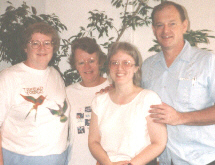 The humans from left to right in the picture are Sandy Robinson, Susanne Stimson, Linda Lee,
Dale Lee.
The humans from left to right in the picture are Sandy Robinson, Susanne Stimson, Linda Lee,
Dale Lee. The clowns from left to right are Blossom, Mischievous, Little Lee, and Slow Beau with two
teenagers that attended the San Fernando Baptist Church. Susanne had two clown characters,
Mischievous and Trendi.
The clowns from left to right are Blossom, Mischievous, Little Lee, and Slow Beau with two
teenagers that attended the San Fernando Baptist Church. Susanne had two clown characters,
Mischievous and Trendi.I was able to visit with a person that had a few months earlier been to Trinidad on a Vacation
Bible School mission trip. She had been to the church where the clowns would be based while in
Trinidad. Her comments about her trip were very helpful in giving me insights I would need to
make my plans. Her advice was extremely helpful about packing, what to take, and what to do
and not do while going through the customs inspection.
As clown team leader, I distributed to the clowns information about the mission trip that I
received from Rev. Rowbottom, the missionaries in Trinidad, and the staff at the International
Mission Board. Faxes were used to save money and quickly transfer information. Most of the
communications with Rev. Rowbottom were faxes.
Rev. Rowbottom was able to give me a tentative performance schedule with the time allowed for
each performance. Programs were planned before leaving on the trip so the appropriate illusions,
props, and materials could be packed. Of course after the clowns started performing, new
combinations of balloons, illusions, and skits were developed once the clowns got to know each
other.
Just the idea that I would need to get a passport was exciting. The forms were filled out with the
required two pictures and delivered to the main post office in Richmond, Virginia. We received
our passports in less than a month which was quicker than I expected.
Getting the immunization shots was not as enjoyable. It was not required that we receive the
Yellow Fever immunization, but it was recommended. The idea that I could have a need for the
Yellow Fever shot caused me to feel uneasy for a few days about going to Trinidad.
Linda and I went to the Henrico County health department to receive the shots. The
immunizations we received were:
Tetanus-Diphtheria booster
Oral polio booster
Yellow Fever
Immune Human Globulin (Hepatitis A)
I was uncomfortable about going through customs in Trinidad, because I had heard horror stories
told by missionaries when they travel from country to country. I made sure the baby power used
in applying clown make-up was in a factory sealed container. I did not want the white powder to
be viewed as cocaine. The clown supplies and props we had in our suitcases were not normal for
a tourist to have in a suitcase. I included a list of the clown related items in each suitcase so it
would look like I was not trying to sneak things into the country. The custom officials looked at
my papers and waved me on through. They did not open my suitcases. All that worry for
nothing.
 The clowns were based at the San Fernando Baptist Church (SFBC) in San Fernando, Trinidad.
The clowns were based at the San Fernando Baptist Church (SFBC) in San Fernando, Trinidad.
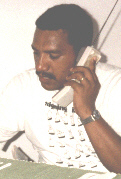 Rev. Wayne Rowbottom, the pastor of the San Fernando Baptist Church.
Rev. Wayne Rowbottom, the pastor of the San Fernando Baptist Church.
9:00-12:30 Clown training conference.
1:00-2:30 Clowns put on their faces and dressed up.
3:00-4:00 Clowns and SFBC puppet team performs at the "Mid-Center" shopping mall.
6:00-7:00 Clowns and puppets perform at the Pizza Boys’ outdoor dining area.
7:45-9:00 Remove make-up and dress as humans.
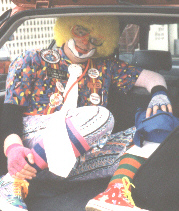 The cars that transported the clowns were small. When the clowns traveled in one car there were
four clowns, a driver, props, and a performing luggage bag packed into the car. Slow Beau and
the performing luggage bag ended up in the car's luggage area which he entered through the hatch
door in the rear of the car.
The cars that transported the clowns were small. When the clowns traveled in one car there were
four clowns, a driver, props, and a performing luggage bag packed into the car. Slow Beau and
the performing luggage bag ended up in the car's luggage area which he entered through the hatch
door in the rear of the car.
Rev. Wayne Rowbottom spent time each day verifying the next day's schedule for the clowns. He
was constantly juggling the clowns' schedule due to organizations canceling performances or
wanting to change the time or date of a performance. The clowns had to be very flexible due to a
constant changing schedule.
The Rowbottom home was the home base for the clowns. Most of the meals were eaten at the
Rowbottom home.
A typical day for the clowns would start about 5:30 a.m. and end about midnight. The clowns
were often in make-up for ten to twelve hours a day. The choice place for putting on the
make-up was the front porch where the light was the best. People walking on the sidewalk by the
house were in for a surprise when the clowns were putting on their faces.
The first performances would be between eight and nine o'clock in the morning. Evening
performances started between six and seven o'clock. One of the days had seven clown
performances and two days had five performances. Each performance was at a different location.
At the mission church in Longdonville, about thirty children were expected. The church leaders
were shocked when one hundred and twenty children attended.
Travel between performance locations was challenging. After each performance, the props and
illusions had to be repacked for the next performance. If the audience was different from one
performance to another performance, I got to pack the performance bag with the needed props
and illusions along with the sheet of paper that contained the order of what would be performed
during the performance. The repacking of the performance bag was done in the car’s luggage
area.
The locations at which the clowns performed are:
Businesses - 2
Churches - 6
Schools & Day-Care Centers - 12
Housing Complexes - 4
Adult Home - 1
Half-Way Home for Battered Women - 1
The schools in Trinidad have school uniforms. The church-sponsored schools are considered a
part of the country's educational system.
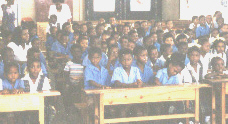 Fifth Company Baptist Church primary school.
Fifth Company Baptist Church primary school.
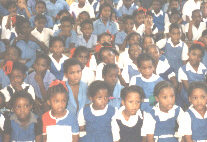 Marac Baptist Church primary school.
Marac Baptist Church primary school.
 Marabella Government primary school.
Marabella Government primary school.
The government school for the deaf was an exciting place for the clowns to perform. This was
the first time for the clowns to work with an interpreter. I performed the needle through the
balloon trick for the children. As I started to insert the needle into the balloon, the children
shocked me by acting like normal hearing children. They scooted across the floor away from me
and put their hands over their ears. Later I was told that even though they may not be able to
hear "normal sounds," the children could often hear the pop of a balloon.
 A very enthusiastic audience. The clowns had to slow down their performance to give the
interpreter time to sign what the clown said to the children. The children had a challenge deciding
when to watch the clown or the interpreter. The deaf children were a wonderful audience.
A very enthusiastic audience. The clowns had to slow down their performance to give the
interpreter time to sign what the clown said to the children. The children had a challenge deciding
when to watch the clown or the interpreter. The deaf children were a wonderful audience.
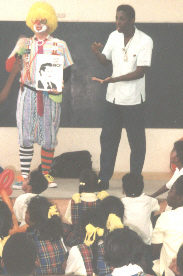 Slow Beau performing the magic illusion, "Freddie," with the interpreter. The job of interpreting
for a clown is difficult. The interpreter had to quickly decide how he would interpret what the
clown was doing and saying.
Slow Beau performing the magic illusion, "Freddie," with the interpreter. The job of interpreting
for a clown is difficult. The interpreter had to quickly decide how he would interpret what the
clown was doing and saying.
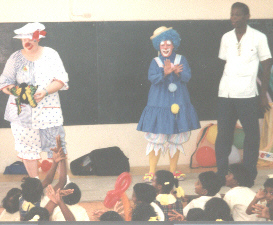 Blossom, Trendi, and interpreter working with the caterpillar to butterfly prop.
Blossom, Trendi, and interpreter working with the caterpillar to butterfly prop.
The clowns performed at the deaf school on Monday. Tuesday night, the clowns performed in the
yard of a home in the Marabella squatters housing area in San Fernando. This is a very poor area
of the town. The shacks that served as homes were built of anything the people could secure.
The children and adults living in the Marabella area were very receptive to the clowns and the
Word of God.
The clowns walked through the streets promoting their performance. I was shocked when
something hit me on my legs. I looked down and saw a small boy with his arms wrapped around
my legs in a big hug. I recognized his school uniform. He was a student at the deaf school. The
little boy's action of hugging the clown surprised his parents. The boy was shy. The boy had
developed a trust in the clowns that visited his school. He liked the clowns.
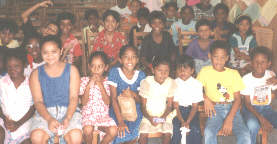 These are a few of the children that attended a clown performance at the Longdonville Mission of the San Fernando Baptist Church. About thirty children were expected. About one hundred and twenty children from the mission's community came to see the clowns. The mission's leaders were very excited. They used this opportunity to obtain information about the children's families.
These are a few of the children that attended a clown performance at the Longdonville Mission of the San Fernando Baptist Church. About thirty children were expected. About one hundred and twenty children from the mission's community came to see the clowns. The mission's leaders were very excited. They used this opportunity to obtain information about the children's families.
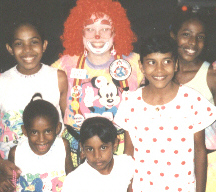 Five girls of the San Fernando Baptist Church that adopted Little Lee as their clown.
Five girls of the San Fernando Baptist Church that adopted Little Lee as their clown.
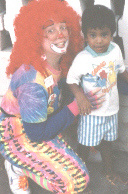 Little Lee and Micah Rowbottom. Micah was a two and one-half year old ball of energy that
enjoyed helping Little Lee put on her make-up and play with the clowns' practice balloons.
Blossom taught Micah some of the words to the song, Oh! Susanna. Micah would get the clowns
to tie the balloons together so he would walk through the house dragging eight feet of balloons
singing at the top of his voice.
Little Lee and Micah Rowbottom. Micah was a two and one-half year old ball of energy that
enjoyed helping Little Lee put on her make-up and play with the clowns' practice balloons.
Blossom taught Micah some of the words to the song, Oh! Susanna. Micah would get the clowns
to tie the balloons together so he would walk through the house dragging eight feet of balloons
singing at the top of his voice.
If the mission team plans to a video and photographs to tell the story of the mission trip after they
return home, I suggest having a team member with the responsibility of operating the still camera
and video camera. The clowns took still photographs as time permitted.
Rev. Rowbottom asked that the clowns not take photographs at a couple of the places that we
performed. Not taking photographs was done out of respect for the people and their feelings.
Some of the places we performed were mission points for the church. The people were poor.
Taking photographs would cause them to become embarrassed for their poor surroundings and
clothes and not be able to listen to what the clowns were saying and doing.
The clowns were in Trinidad for eight full days. The one day that was devoted to sightseeing had
one clown resting and reading while the other clowns toured the Asa Wright Nature Center and
shopped at the Circular Mall in Port of Spain.
The Asa Wright Nature Center was once a private coffee, cocoa, and citrus plantation. The
center is a great place for bird watching. The center is known for the many species of humming
birds that can be seen at the center. The humming bird migration north started about two weeks
before the mission trip. There were many species still at the center. It was an exciting time to
watch the bright colored humming birds.
A walking trip was taken by the clowns (without make-up) and their missionary tour guides.
Coffee trees, mango trees, lovely flowers, and many birds were seen on the walking tour.
A cashew looks very strange before it is prepared to be eaten. Did you know a cashew is
poisonous to eat before it is roasted?
We got to eat tree ripen sweet mangos which are very good. How did we know the mangos were tree ripen? We picked them up off the ground. There is a BIG difference between the taste of a tree ripen mango and one purchased in a grocery store in Richmond, Virginia.
The restaurant at the center's Lodge was unique. It was built around a very large tree. There
were some large branches running through the room and out the roof. The lunch at the Lodge
was delicious, and very hot light green pepper rings were served in a sauce with the meal.
The exchange rate during the mission trip was $5.60 TT (Trinidad & Tobago) dollars for one
United States dollar.
Shopping at the Circular Mall in Port of Spain was very similar to a medium sized mall in the
USA. The prices in the mall were similar to prices in the USA after the prices were converted to
US dollars. The grocery store in the mall looked like any major grocery store in the US. One
thing that got my attention was the fruit flavored carbonated drinks. The grocery store carried 10
to 12 fruit flavored drinks. I would like to have tasted the drinks.
At the mall, Linda and I had a meal of fish (King fish and Flying fish) and chips. An order of King
fish, an order of Flying fish, and two large drinks cost $32.51 TT. Both types of fish were good.
Twelve pieces of Kentucky Fried chicken and twelve biscuits cost $71.22 in TT dollars. After
converting the Kentucky Fried chicken prices to US dollars, the price was about the same as KFC
prices in Richmond.
To put the prices in Trinidad in perspective, a school teacher makes about $800.00 TT dollars a
month or $142.86 in US dollars. This pay scale makes the prices very high to the people that live
in Trinidad. Except for some meat and vegetables, most things used by people in Trinidad are
imported which raises the prices.
There was one meat shop that the clowns frequently drove by on their trips. The live goats were
tied beside the building and dressed goat quarters were hanging from the ceiling of the building's
porch. One time there was a goat’s head hanging from the ceiling. Whole chickens were sold at
the meat shop. The chickens had been plucked and were hanging by their feet from the ceiling of
the porch.
I had been told that in Trinidad clowns are often identified with voodoo and black magic so some
people are afraid of clowns. I did not get the feeling that any of the children or adults at our
performances were afraid of the clowns. The children's reactions to the clowns were no different
from American children.
The clowns got to have lunch with a church member's family. The clowns got to walk through
their garden. The garden had coconut, mango, and banana trees. I would have like to have spent
more time with the church members.
Being a first time mission trip team leader was a challenge for me. Plans seemed to constantly
change. Most of the challenges I faced as a team leader would be common to any mission trip.
The mission team members are guests in the country. They are to remember this fact and act
appropriately.
A team leader has to work with people when they start to react to the stress of the mission trip.
On a mission trip, you will get to see the person's true personality. The more flexible a person is,
the easier he will be able to react to unplanned changes. A very rigid personality will present
surprises and challenges to the team leader.
There were some unique challenges to the clowns. Limitations when in make-up or having to put
on make-up a couple of times a day did limit some interaction with the host of the clowns on
some days. The clowns allowed about an hour and a half for applying make-up, preparing props
and balloons and getting dressed. Of course the clowns had to change from a clown to a human
when they returned their home base. The dama team did not have these time concerns.
Some factors that influence how stress affects team members.
Change of sleeping environment such as a different type of bed and different room mate.
Eating different foods and having a different eating schedule.
Schedule changes.
Missing the support system they had at home.
Different language.
Different culture.
Different climate.
Lack of privacy and desired personal space.
Taking care of personal hygiene needs.
Changes in personal routines.
Washing and drying clothes.
Not knowing the people on the team or the people where you are conducting the mission trip.
Not having adequate resources.
Personality flexibility.
Personnel energy level and physical fitness.
The team leader and members will not enjoy the mission trip if the team has a member that is a control freak .
I am glad to say that the clowns did not get sick while visiting Trinidad. I do not want to think
about what would have had to be done if a person got sick and needed to see a doctor.
The team leader has to keep the objectives of the mission trip in focus at all times. The focus of
some of the team members will become self-centered as they start reacting to the stressful
conditions. It is a challenge to be a team leader. It will be good if a procedure is in place to allow
people to express concerns before a situation gets out of control. The team leaders will need to
be trained in conflict management skills.
I learned that mission team members must do as instructed by the missionaries and the people
living where they are going. I was given specific instructions concerning how to fill out the forms
required by the immigration authorities for us to be allowed to enter Trinidad. The drama team
members did not fill out the immigration forms as they were instructed. Rev. Rowbottom had to
spend parts of two days meeting with the immigration authorities to get them to change their
decision about sending the drama team members back to the USA. The drama team arrived on
Saturday, but they were not cleared by the immigration authorities until Monday morning. The
immigration authorities believed the drama team members to be Mormons or Jehovah's Witness.
It seems that at that time, the government officials were not in favor of Mormons and Jehovah's
Witness members being allowed to enter the country. Without Rev. Rowbottom's intervention,
the drama group's members would have been put on the next available airplane going to the USA.
Visiting the Asa Wright Nature Center on the clown’s day off was the only tourist attraction the
clowns visited while in Trinidad. When the clowns left Rev. Rowbottom’s house to go to where
we would perform, often the only thing I knew about where we were going was the direction we
would be traveling from his house and about how long it would take to get to the location.
One thing I wanted to do was to watch and hear a person play the pan which was developed from
the end of an oil barrel. Sorry about not being able to describe it using musical terms. I did not
get to do this so I thought. The last night spent in Trinidad was at the home of one of the
missionaries that lived in Port of Spain. I woke up early the next morning. While resting in the
bed, I heard a beginner practicing playing a piano. It seemed like they were playing using one
finger. Later I found out that what I heard was someone practicing playing a pan. When I
assumed that the person was practicing playing a piano caused me to not be able to understand
what I was hearing.
We participated in the non tourist side of Trinidad. We were with the people that lived in
Trinidad. I saw a lot of the roads from the back of a car. Of the people we met, few got to see us
in our human dress. When the clowns were not riding in a car or performing, we often were at
the Rowbottom’s house which was next to the San Fernando Baptist Church.
The people we met were very receptive and friendly to the clowns. The humans received the
same response.
I was told about the official pot hole. I was not sure if I was told the truth. The pot hole was
located in the middle of a road. The hole was about three to four feet across and about two feet
deep. The pot hole was marked with a four inch wide white stripe painted around the edge of the
hole. The person that told me about the pot hole did not remember in which road the pot hole
was located. I was told about the pot hole about three months before I went to Trinidad.
I was not thinking about the pot hole when I got to Trinidad. If I was told the truth, it must have
been repaired by the time I got there. I was shocked when I first saw the white stripe lined pot
hole. It was in the middle of a four lane road on which the cars were traveling about 40 miles an
hour. There were no orange cones or barriers around the pot hole to help drivers see the danger.
The white stripe was the warning signal to drivers.
I did not get a good explanation about the reasons behind the pot hole. All I know is I saw it
several times. I never did know which road the pot hole called home.
There will be opportunities for Christians from different cultures to get to know each other and
work together. The Christian’s from the USA will get to interact with non Christians from
another culture. The broadening of the experience by being a part of another culture will often
cause the USA Christians to have a different attitude toward working with different “types” of
people where they live. There is not a need to travel long ways to find people with needs. To
some Christians, participating in a mission trip to another country is a step in learning how to
reach out to people in their communities.
March 2008